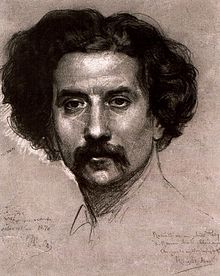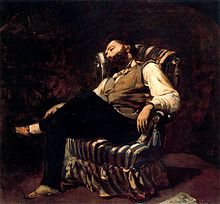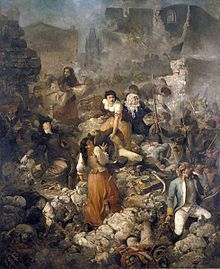- Ramon Martí Alsina
-
Ramon Martí i Alsina 
Self-Portrait, 1870.Birth name Ramon Martí i Alsina Born 1826
Barcelona, Catalonia, SpainDied 1894
Barcelona, Catalonia, SpainNationality Spanish, Catalan Field Painting Movement Eclecticism, Realism Influenced by Courbet Influenced Modest Urgell, Joaquim Vayreda Ramon Martí i Alsina (Catalan pronunciation: [rəˈmom mərˈti j əɫˈsinə], Spanish: Ramón Martí Alsina) (1826-1894), was a Catalan Realist painter. He studied in Barcelona at La Llotja school of art under Antoni Ferrant, Claudi Lorenzale and Lluís Rigalt, among others. He made several trips to Paris in successive stages over which he came to know the work of Courbet, the French Realists and the Barbizon school. Although he was primarily a realist, his early works were influenced by Romanticism and in his later works, he began adapting the tenets of Impressionism, hence some critics consider him an Eclectic painter. He is considered the best representative of Spanish Realism and is credited with introducing Courbet's ideas into Catalonia.[1]
Contents
Main Works
Although he was primarily a landscape painter, two of his most renowned works are historical paintings and a third is a genre scene:
- The Great Day of Girona or Girona's Great Day (El gran dia de Girona, completed by 1863-64)
- The Siesta or The Nap (La Migdiada, ca. 1884)
- The Santa Bàrbara Company (La Companyia de Santa Bàrbara, ca. 1891), also about the siege of Girona by French troops.
References
- ^ Tharrats, Joan Josep. Cent Anys de Pintura a Cadaqués. Barcelona: Parsifal Edicions, 2007, p. 211. ISBN 84-95554-27-5.
See also
External links and sources
- Entry on Ramon Martí i Alsina in the Gran Enciclopèdia Catalana (in Catalan).
- Artehistoria.com site short biography (in Spanish)
Categories:- 1826 births
- 1894 deaths
- Catalan painters
- Spanish painter stubs
Wikimedia Foundation. 2010.


